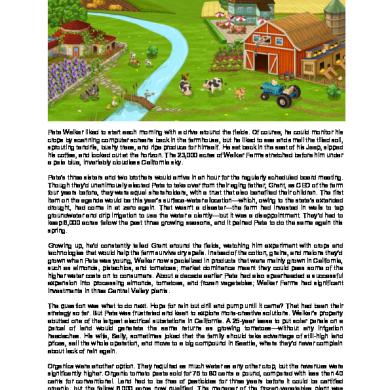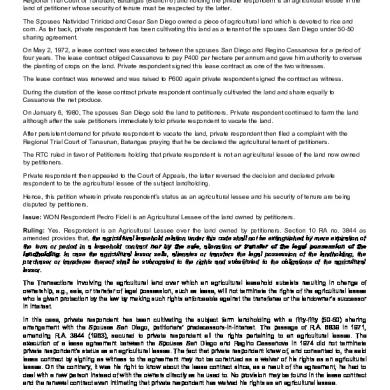* The preview only shows a few pages of manuals at random. You can get the complete content by filling out the form below.
Description
Case 2: How Would You Save This Farm?1
Pete Walker liked to start each morning with a drive around the fields. Of course, he could monitor his crops by scanning computer screens back in the farmhouse, but he liked to see and smell the tilled soil, sprouting tendrils, bushy trees, and ripe produce for himself. He sat back in the seat of his Jeep, sipped his coffee, and looked out at the horizon. The 23,000 acres of Walker Farms stretched before him under a pale blue, invariably cloudless California sky. Pete’s three sisters and two brothers would arrive in an hour for the regularly scheduled board meeting. Though they’d unanimously elected Pete to take over from their aging father, Grant, as CEO of the farm four years before, they were equal shareholders, with a trust that also benefited their children. The first item on the agenda would be this year’s surface-water allocation—which, owing to the state’s extended drought, had come in at zero again. That wasn’t a disaster—the farm had invested in wells to tap groundwater and drip irrigation to use the water e ciently—but it was a disappointment. They’d had to keep 6,000 acres fallow the past three growing seasons, and it pained Pete to do the same again this spring. Growing up, he’d constantly tailed Grant around the fields, watching him experiment with crops and technologies that would help the farm survive dry spells. Instead of the cotton, grains, and melons they’d grown when Pete was young, Walker now specialized in products that were mainly grown in California, such as almonds, pistachios, and tomatoes; market dominance meant they could pass some of the higher water costs on to consumers. About a decade earlier Pete had also spearheaded a successful expansion into processing almonds, tomatoes, and frozen vegetables; Walker Farms had significant investments in three Central Valley plants. The question was what to do next. Hope for rain but drill and pump until it came? That had been their strategy so far. But Pete was frustrated and keen to explore more-creative solutions. Walker’s property abutted one of the largest electrical substations in California. A 25-year lease to put solar panels on a parcel of land would generate the same returns as growing tomatoes—without any irrigation headaches. His wife, Sally, sometimes joked that the family should take advantage of still-high land prices, sell the whole operation, and move to a big compound in Seattle, where they’d never complain about lack of rain again. Organics were another option. They required as much water as any other crop, but the revenues were significantly higher. Organic tomato paste sold for 75 to 80 cents a pound, compared with less than 40 cents for conventional. Land had to be free of pesticides for three years before it could be certified organic, but the fallow 6,000 acres now qualified. The manager of the frozen-vegetables plant was pushing him to make the leap. 1
Source: Reinhardt, F.L. and Beard, A. (2016) Case Study: How Would You Save This Farm?, Harvard Business Review, 12 August 2016.
1
As he pulled into the farmhouse driveway, Sam, his younger brother, waved from the kitchen door. Pete looked at his watch. “You’re early!” he shouted. “I know,” Sam shouted back, grinning. “But might as well get three full meals of Mom’s cooking while I’m here.” Walker board meetings were always followed by family fun days. The siblings’ wives and husbands and children would come for a working day on the farm, sandwiches out in the fields, and a big picnic dinner that evening. Pete started these days nervous—it was tough to run a business that supported three generations of your family, navigating disagreements and making tough calls—but by sunset he always managed to relax. This farm and family was his father’s legacy. Keeping it together would be his. The Meeting “Zero? You’ve got to be kidding me. How can they give us zero of our allocation again? Rainfall’s up this year—a bit.” “It is what it is, Bill,” Pete told his older brother. “I can’t argue with the bureaucrats.” Federal agencies determined how much and to whom water would flow from the Central Valley Project, a multibilliondollar system of dams, reservoirs, canals, and aqueducts designed to keep the region from drying out, even in the midst of a drought. Maintaining the flow of fresh water in the rivers, to protect the habitat of endangered fish, took legal precedence over delivery to farmers. “Do we need to start looking at transfers?” Bill asked. California had a nascent system through which farmers could obtain “supplemental” water from sellers in naturally wetter irrigation districts, but it was hugely inefficient. The year before, prices had jumped to $800 per acre-foot of water; this year they would be even higher. Water from Walker’s own wells cost just $200 per acre-foot, and the surfacewater allocation—when they could get it—cost even less. “Costs are still way too steep,” Pete said. “We’re better off using the groundwater we have and keeping elds fallow if we need to. We have enough water to get by.” “But we can’t go on like this forever,” Bill said. “How long can the government refuse to give us the water we’re supposed to be getting?” Walker Farms hadn’t received 100% of its allocation since 2006. Mary, the oldest sister, piped up. “I’ve said it before, and I’ll say it again. This is climate change. We have to assume that it’s the new normal.” “Don’t let Mom hear you talking that ‘quack science,’” her sister Isabel teased. When she and Mary had tried to show their parents An Inconvenient Truth a few years back, their mother had muttered something about “damn liberals” and walked out of the room.
2
The siblings were of diverse minds politically, but they agreed that temperatures were rising and weather patterns were becoming more volatile. What that meant for the farm over the next two decades or so was up for debate. Some thought it would be debilitating; others, business as usual, because the good years would continue to balance out the bad. “The obvious answer is to drill more wells,” Bill said. “Everyone else is doing it. If we drill 10 more, we can quit fallowing all that land. It’s our water. It’s right there.” “But well water’s not as good as surface water: The dissolved salts in it will eventually kill our trees,” Mary said. “And extracting too much groundwater makes the land subside. Anyway, the state government is talking about imposing regulations on drilling.” “All the more reason to drill the wells now,” Bill countered. “But that’s just a temporary x,” Mary insisted. “What we need in the long run is a real water market, like Israel’s or Australia’s. For all the other inputs we need to grow our crops, the government lets supply and demand do their magic. But not water. It just kills me that water doesn’t move to its highest and most productive use. People who get it cheap or even free have almost no incentive to sell it to people for whom it’s more valuable. Only one percent of the water in this state gets traded. One percent!” “Should we really keep betting the whole farm—pun totally intended—on a diminishing resource?” Isabel asked. “Land prices are so high. If we can’t use the 6,000 acres for another year, why not sell and let someone else worry about the water risk? Wait—didn’t you have a solar proposal to show us, Pete?” Pete nodded and handed out the relevant documents. One was a brochure picturing an expanse of mirrored panels. “Wow—that’s ugly,” Sam said. “Certainly not as pretty as almond trees,” Pete agreed. “The panels are pretty in their own way,” Isabel said. “Sleek, modern, progressive.” Pete explained the lease structure and the projected returns. His sister Jane nodded. “So we’d make as much as we would growing tomatoes? Not a bad trade.” “Except we’d be giving up our ability to farm the land for 25 years,” Bill said. “That’s crazy.” “In 25 years you might nd that we don’t have enough water to keep even 10,000 acres thriving,” Jane shot back. “Guaranteeing a solid return on this parcel will seem like a smart move. We might even want to expand the operation.” Panels instead of plants all over the farm, Pete thought. He couldn’t picture it. “We should also talk about organics,” he said. “Yes, we should,” Sam said. After getting his agricultural sciences degree, he’d done an internship at Whole Foods, and he’d been talking Pete’s ear off about organics’ pricing power ever since. “If we want to use the fallow 6,000 acres this year, a few organic crops might be the way to do it. The fields have been clean for three years, so we’ve already absorbed those costs. Of course, we’d have to tap into our groundwater reserves to get them going. But we know we can charge a big premium for the produce: fewer tons per acre, but more dollars per ton.” Bill jumped in. “We’ve talked about this before, Pete. Do we really want to hitch our cart to that bandwagon? Everyone in the business knows that organics are a sham—no proven health benefits over conventional produce. At some point consumers are going to figure that out.”
3
“I can introduce you to some very smart people—and millions of grocery store customers—who disagree,” Sam countered. “The category is growing by leaps and bounds, Bill. And even if they’re wrong, they’re still spending money. Why shouldn’t we get in on the game?” “We can’t keep chasing higher-yield crops to offset our astronomical water costs,” Jane said. “At some point we’ve got to address the root of the problem. Pete, did you have any luck getting in to speak with the governor?” “Honestly, the bureaucracy is so thick,” Pete said, “it would be a full-time job to navigate it. I’ve got to focus on running the farm.” His siblings all nodded solemnly. “So what do you think, Pete?” Bill said. “We always have these discussions and share our opinions. But you’re the real expert, and we trust you. What do you think we should do?” “Let me think about it. We have a few other agenda items to get through. And the kids should be here soon. I don’t want the party to start late on my account.” The Picnic Pete was keeping a close eye on seven boys, his sons and nephews, as they clambered up and around one of the big tractors. His mother, Helen, had overseen the production of a spectacular meal—grilled steaks, chicken, and vegetables; potato salad; and strawberry shortcake for dessert—and everyone would soon be heading back home to Mountain View, Monterey, or Ventura. Pete’s family and his parents were the only ones who still lived in the farmhouse. Grant ambled up behind him. “How was the board meeting this morning?” he asked. “Good. We miss having you there. You should come.” “Nope, when I stepped down, I promised your mother and myself that I wouldn’t meddle. You know where I am if you ever need advice.” “I still can’t believe that zero allocation,” Pete said. “It is what it is,” said his father. “But I don’t want to keep so much of the farm fallow again.” “I wouldn’t either. It’s a waste.” “We could try experimenting with organics,” Pete said. Grant scowled. “Or consider leasing some land to that solar panel company.” His father scowled again and said, “Those are your best options?” “We could plant more almond or pistachio trees. Otherwise, if I want to use those acres, I need either high yields from another crop or guaranteed ones that don’t require me to use water.” “Water—that is the issue,” Grant said. “When you were growing up, it used to rain more.” “I remember.” “So your job is tougher than mine was, son. But I know you can do it. Look at those beautiful almond trees! California is still the best place in the world to be a farmer.” Questions to ponder: 1. What are the operational problems that are currently being faced by Pete Walker? Explain. 2. How could product variety impact on business operations of the farm? 3. What, if any, can Pete do to improve his farm’s efficiency by using contemporary technology? 4. What should Pete do with the 6,000 acres?
4













